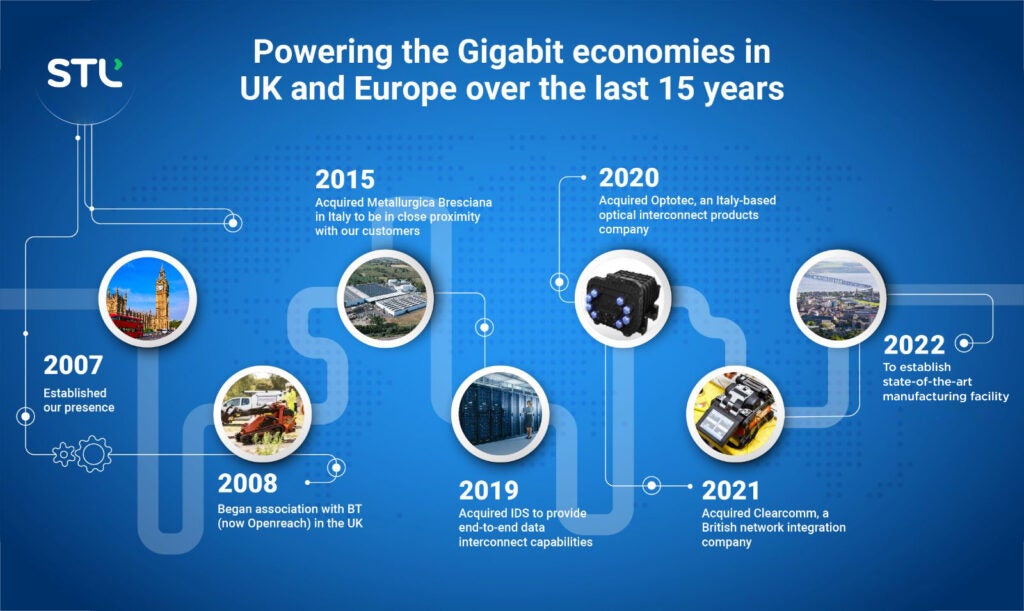Meet the company behind UK’s Gigabit broadband rollout
THE ARTICLES ON THESE PAGES ARE PRODUCED BY BUSINESS REPORTER, WHICH TAKES SOLE RESPONSIBILITY FOR THE CONTENTS

STLis a Business Reporter client
Millions of homes are being powered with fast broadband connections across the United Kingdom.
Home to more than 60 million internet users, the UK is going through a connectivity revolution with millions of homes set to enjoy improved broadband speeds. The service providers in the UK are continuously upgrading their fibre optic backbone networks and communications infrastructure in this direction. Sterlite Technologies Limited (STL) is supporting the top telecom and digital service providers across Europe in its large-scale network build-outs. Ankit Agarwal, Managing Director at STL, tells us about how the company has grown to become the UK’s most reliable digital network partner.
How long has STL been active in the UK and who are you working with?
We entered the UK market in 2007 and at around the same time, Openreach was spun out of BT to become the country’s main network infrastructure provider. We have been working with Openreach for the last 14 years.
In recent years, as Openreach has focused on rolling out the UK’s first full fibre network, we have strengthened our relationship, and today we are a preferred partner – playing a key role in helping Openreach connect millions of homes.
New fibre providers are emerging and STL is working with most of them – right from Tier 1 telcos to reputed alternate service providers.
How is STL enabling digital transformation in the UK?
We started small in the UK, but we always saw it as our second home market and looked at the digital landscape holistically. In the optical fibre industry, delivery lead times have always been a crucial challenge. We set out to solve this problem for the European market around 2015. We acquired a local Italy-based operator and set up the most advanced manufacturing of optical cables to cater to the demand in the UK and Europe.
We later also acquired Optotec, an optical interconnect company in Italy. This category of products is the single biggest driver of rolling out FTTx really fast. On the data centre front, we strengthened our interconnect capabilities and have been connecting data centres across Europe. Quite recently, we set out to enable operators in the UK to deploy FTTx very fast by setting up our services business in the UK and acquiring Clearcomm – a UK-based network integration company. As of now, we have close to 200 employees across the UK.

We are in the process of building a new manufacturing presence in the UK that will focus on the design and manufacture of fibre solutions such as Celesta, STL’s high-density optical fibre cable. This facility will also serve as our UK hub for 5G research and innovation.
How do fibre networks relate to 5G? What can the UK do to its digital networks to expand its 5G coverage?
In simple words, a strong optical fibre architecture provides high capacity and bandwidth to a 5G network. With the 5G network, emerging technologies like Video on Demand (VoD), IoT and artificial intelligence will burst out inordinate amounts of data. To handle this data, service providers are upgrading their backhaul networks with fibre technology that will enable them to deliver unlimited bandwidth.
For the UK to expand its 5G vision, along with a strong optical fibre footprint, it also needs open, disaggregated, programmable networks that can support the 5G use cases. The UK government recently launched a £30 million competition to fund R&D projects that accelerate adoption of OpenRAN and position the country as a leading player in a new era of disaggregated networks. The sovereign also requires robust and quick network deployment that delivers stage-wise excellence. STL, with its unique capabilities across all layers of the network, is well-positioned for this space.
What will be the wider social impact of these digital networks?
The need for ubiquitous internet connectivity is greater than ever. These digital networks will shape everything from GDP and industry momentum to inclusion and equal opportunity. As a society, we need to invest in developing fibre-powered broadband highways that reach every corner of the UK – and the world. The digital sector contributes £149 billion to the UK economy and currently employs 2.9 million people. According to McKinsey, improving infrastructure could add $13 trillion to global GDP by 2030, transforming billions of lives in the process.
What is the impact of digital technology on sustainability?
Over the past year-and-a-half, the world has witnessed the power of digital networks and technologies in unexpected ways. Increased digitalisation brings with it a great opportunity for more sustainable activities. Future businesses and societies will have sustainability at their core. Having said that, as industry captains in the technology space, it’s our responsibility to bring sustainability to the centre of all business agendas. STL has always relied on technology-led innovation and the same applies to our sustainability efforts. We have integrated our operations and CSR programmes with the UN Sustainable Development Goals (SDGs). For example, we became the first optical fibre and cable producer globally to be Zero Waste to Landfill certified, and by 2030 we aim to become a Net-zero emission and water positive company.
To find out more, visit www.stl.tech
Originally published on Business Reporter
